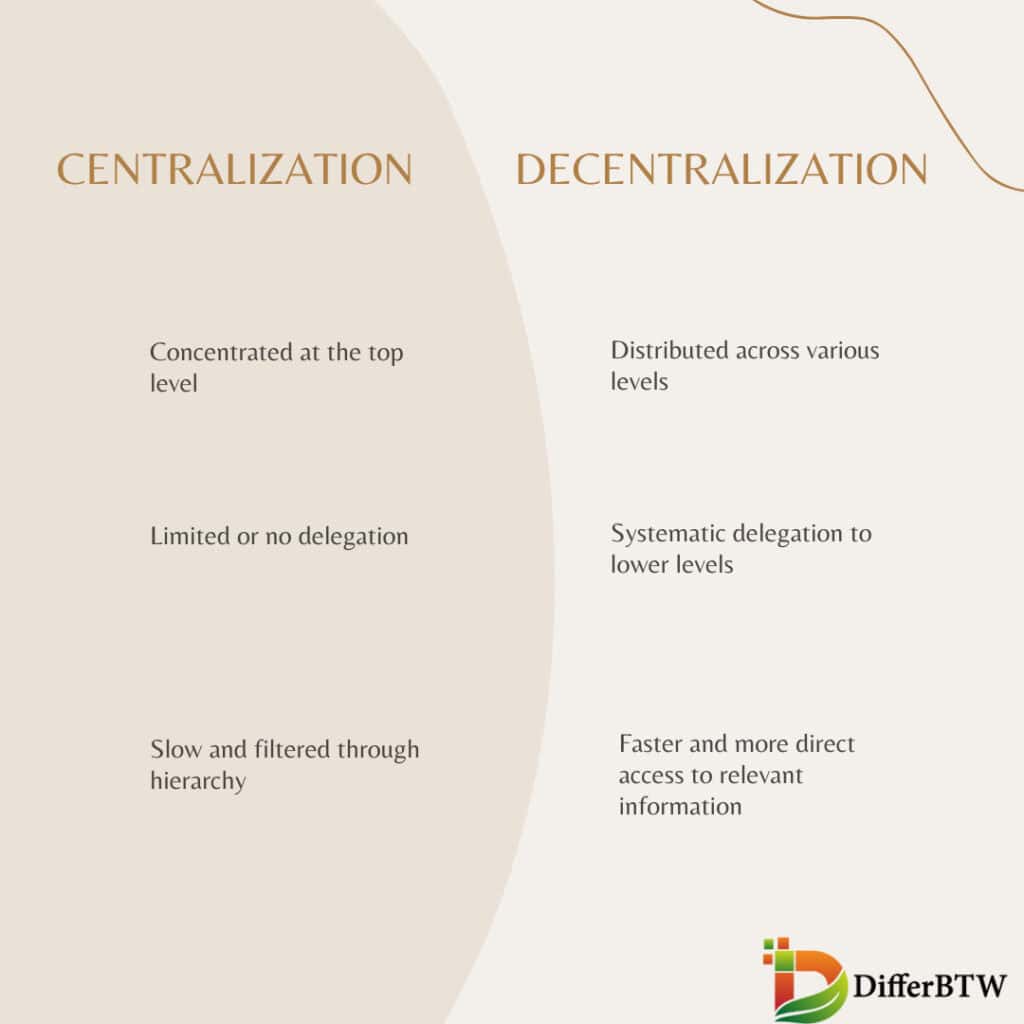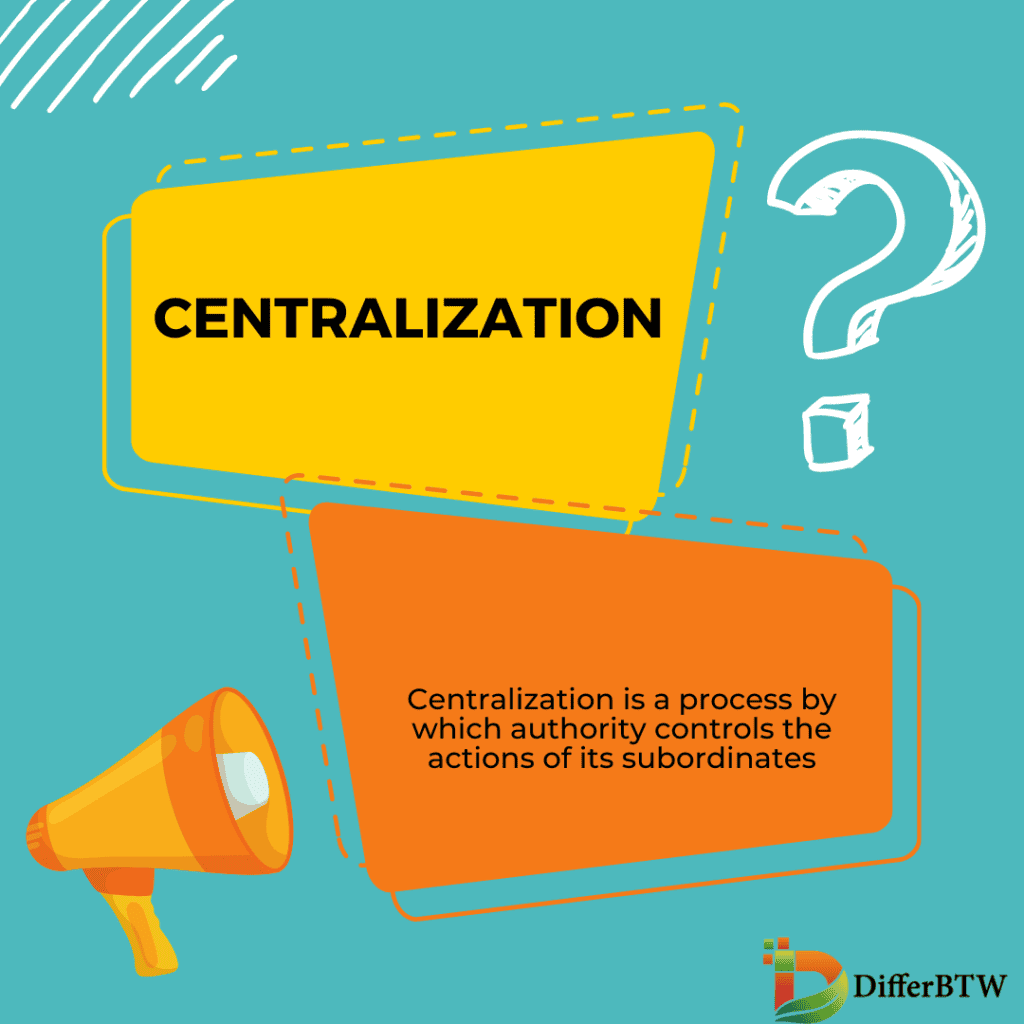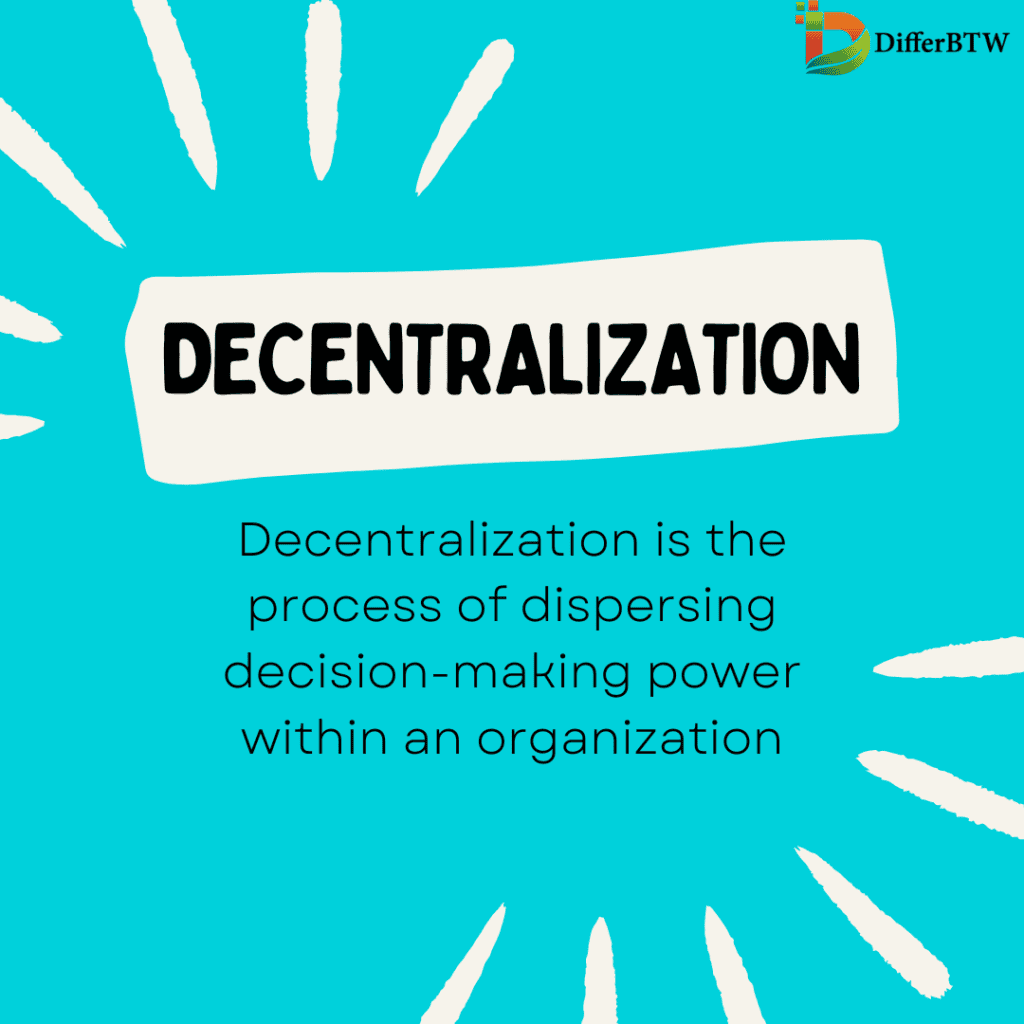Centralization and decentralization are two contrasting approaches to the distribution of power and decision-making within an organization or system. In a centralized structure, authority and control are concentrated at the top, with a single entity or a small group making decisions for the entire organization. This approach allows for standardization, consistency, and efficiency, as all activities are coordinated and directed from a central point.
Decentralization involves the dispersion of power and decision-making responsibilities to lower levels of the organization or system. This approach empowers individuals or smaller units to make decisions independently, fostering autonomy, flexibility, and local responsiveness. Decentralization can lead to increased innovation and adaptability, as those closest to the issues can make decisions based on their unique circumstances.
However, it may also result in a lack of coordination and consistency across the organization. The choice between centralization and decentralization depends on various factors, such as the nature of the organization, its goals, and the environment in which it operates.
Comparison Chart
| Parameter of Comparison | Centralization | Decentralization |
|---|---|---|
| Decision-Making Authority | Concentrated at the top level (few people) | Distributed across various levels (more people involved) |
| Delegation of Authority | Limited or no delegation | Systematic delegation to lower levels |
| Information Flow | Slow and filtered through hierarchy | Faster and more direct access to relevant information |
| Employee Motivation | Can be demotivating due to lack of ownership | Can be motivating due to increased responsibility and ownership |
| Speed of Decision-Making | Slower due to approval processes | Faster due to closer proximity to problems and opportunities |
| Adaptability | Less adaptable to changing environments | More adaptable due to quicker decision-making at lower levels |
| Innovation | Limited due to fewer ideas being considered | Encouraged due to diverse perspectives and ownership |
| Risk Management | Easier to maintain control and assess overall risks | Can be more challenging to ensure consistency and compliance |
| Suitable for | Small organizations, standardized processes | Large organizations, complex environments |

What is Centralization?
Centralization is a process by which authority controls the actions of its subordinates. When an authority centralizes, it becomes its subordinates’ sole decision-maker and point of contact. There are different types of centralization, including political, economic, and cultural. Each type of centralization affects those under the authority’s control differently. Political centralization, for example, leads to a loss of individual liberty, while economic centralization can lead to a loss of economic opportunity.
This results in reduced communication and contact between the centralized authority and other parts of the organization. The decision-making process may also become more centralized because of centralization. The purpose of Centralization is to make decision-making more efficient and to allow for more consistent implementation of organizational policies.
While the definition and characteristics of centralization vary depending on the author, centralization refers to the concentration of decision-making power in a single individual or organization. Those in charge seek to maintain as much control as possible when making decisions. This may be done to keep the decision-making process efficient or prevent rival factions from developing.
The opposite of centralization is decentralization, which disperses power among several individuals. Centralization occurs when decision-making authority rests with a small group of people within an organization. The decisions made by this group have a significant impact on the organization.

Benefits of Centralization
Centralization offers several potential advantages:
- Efficiency: Centralized decision-making can lead to faster and more streamlined processes, as there are fewer layers of bureaucracy and fewer individuals involved in the decision-making process.
- Consistency: With a central authority making decisions, there is greater consistency in policies, procedures, and standards across an organization or system.
- Coordination: Centralization facilitates better coordination and alignment of activities, as the central authority can ensure that all parts of the organization are working towards common goals.
Drawbacks of Centralization
However, centralization also has its drawbacks:
- Lack of Flexibility: Centralized systems can be rigid and slow to adapt to changing circumstances, as decision-making is concentrated at the top and may not be responsive to local needs or conditions.
- Limited Participation: Centralization can limit the participation and input of individuals at lower levels of the hierarchy, leading to a lack of diversity in perspectives and ideas.
- Potential for Abuse: When power is concentrated in the hands of a few, there is a risk of abuse or misuse of that power, as there may be insufficient checks and balances.
Centralization in Different Contexts
Centralization manifests itself in various contexts, each with its own unique characteristics and implications.
Political Centralization
In a politically centralized system, the national government holds the majority of power and decision-making authority. This can lead to a strong central government that can effectively implement policies and coordinate activities across a country. However, it can also result in a lack of local autonomy and the potential for the central government to become disconnected from the needs and concerns of different regions.
Economic Centralization
Economic centralization refers to the concentration of economic power and control within a small group of individuals or entities, such as large corporations or state-owned enterprises. This can lead to economies of scale and the ability to mobilize significant resources towards specific goals. However, it can also result in reduced competition, limited innovation, and the potential for economic inequality.
Organizational Centralization
In a centralized organization, decision-making authority is concentrated at the top of the hierarchy, with lower-level employees having limited autonomy. This can facilitate greater control and coordination across the organization, but it can also lead to a lack of flexibility and responsiveness to local needs.
Examples of Centralization
- The Federal Reserve System: The Fed is the central bank of the United States, responsible for managing the country’s monetary policy and overseeing the banking system. It’s a prime example of financial centralization.
- The Soviet Union: The former Soviet Union was known for its highly centralized government, where all decisions were made by the Communist Party leadership in Moscow, and power was concentrated at the top.
- Apple Inc.: Apple is known for its tight control over its products, from design to distribution. The company maintains a high degree of centralization in its decision-making and operations.
- The Catholic Church: With the Pope as its central authority, the Catholic Church is a classic example of a centralized religious organization, where doctrine and policy flow from the top down.
- The United Nations: While the UN is an international organization, it represents a centralized approach to global governance, with its headquarters in New York City and its various agencies and programs operating under a unified structure.
What is Decentralization?
Decentralization is the process of dispersing decision-making power within an organization. This results in more excellent communication and contact between the centralized authority and other parts of the organization. The decision-making process may also become more decentralized because of decentralization. Decentralization is the process of dispersing power away from a central authority and distributing it among individuals or smaller groups.
Decentralization can also be used to increase organizational flexibility and creativity and to allow for more responsive decision-making. However, decentralization can also lead to a loss of control over organizational resources, making it more difficult for an organization to implement policies consistently.
Decentralization can also lead to a more decentralized organizational structure, as an authority is dispersed among different levels and units within the organization. Decentralization can have several advantages, including improved responsiveness to environmental changes and greater involvement of employees in decision-making. However, decentralization can also lead to a loss of control over organizational resources and increased conflict between different parts of the organization and can lead to a more democratic decision-making process, it can result in a loss of control and efficiency, and it can make it more difficult for an organization to implement policies consistently.

Benefits of Decentralization
Decentralization offers several potential benefits, including:
- Increased resilience and fault tolerance: Decentralized systems are less vulnerable to single points of failure. If one node in the network fails, the overall system can continue to function.
- Enhanced security and privacy: Decentralized networks can provide better security and privacy by distributing data across multiple nodes and employing encryption techniques.
- Greater transparency and accountability: Decentralized systems promote transparency by making data and transactions publicly verifiable on a blockchain.
- Reduced reliance on intermediaries: Decentralization can eliminate the need for intermediaries, reducing costs and increasing efficiency in various processes.
- Empowerment of individuals: Decentralized systems can give individuals greater control over their data, assets, and decision-making.
Challenges and Considerations
While decentralization offers many potential benefits, it also presents several challenges and considerations:
- Scalability: Decentralized systems can face scalability issues as the number of participants and transactions grows, leading to slower transaction times and higher fees.
- Governance and coordination: Decentralized systems require effective governance mechanisms to ensure smooth operation and resolve disputes among participants.
- Regulation and compliance: Decentralized systems can pose challenges for regulatory compliance, as they operate outside traditional legal frameworks.
- User experience: Decentralized systems may have a steeper learning curve for users compared to centralized alternatives, which can hinder adoption.
Examples of Decentralization
- Bitcoin and other cryptocurrencies: These digital currencies operate on decentralized networks, where transactions are validated and recorded by a distributed network of users, rather than a central authority.
- The Internet: The Internet is a decentralized network of networks, with no single entity controlling its operation. This decentralization has been key to its growth and resilience.
- Grassroots political movements: Decentralized political movements, such as the Arab Spring or the Occupy Wall Street protests, rely on local organizing and decision-making rather than top-down leadership.
- Open-source software: Projects like Linux and Wikipedia are built on a decentralized model, where a community of contributors collaborates to create and maintain a shared resource.
- Farmers’ markets: These local markets provide a decentralized alternative to the centralized food distribution system dominated by large supermarket chains. They allow small-scale producers to sell directly to consumers.
Differences Between Centralization and Decentralization
Decision-making authority
- In a centralized system, decision-making power is concentrated at the top, with a single authority or a small group of individuals making decisions for the entire organization.
- Decentralized systems distribute decision-making authority among multiple entities or individuals, allowing for more autonomy and local decision-making at various levels of the organization.
Communication and information flow
- Centralized structures rely on top-down communication, where information flows from the central authority to the lower levels of the organization.
- Decentralized systems promote more horizontal communication, enabling direct interaction and information sharing among different entities or individuals without the need for a central intermediary.
Adaptability and flexibility
- Centralized organizations may struggle with adapting quickly to changing circumstances, as decisions need to be approved by the central authority, which can be time-consuming.
- Decentralized systems tend to be more agile and responsive to local needs and changes, as decision-makers are closer to the ground and can react more swiftly to evolving situations.
Efficiency and coordination
- Centralization can lead to greater efficiency in terms of resource allocation and coordination, as the central authority can optimize processes and ensure consistency across the organization.
- Decentralized systems may face challenges in terms of coordination and standardization, as each entity operates with a degree of autonomy, potentially leading to duplication of efforts or inconsistencies.
Innovation and creativity
- Centralized structures may limit innovation and creativity, as individuals at lower levels have less autonomy to experiment and propose new ideas.
- Decentralized systems can foster a more entrepreneurial and innovative spirit, as individuals and entities have the freedom to explore new approaches and solutions tailored to their specific contexts.
Accountability and control
- In a centralized system, accountability is clearly defined, with the central authority bearing the ultimate responsibility for the organization’s actions and outcomes.
- Decentralized systems may have more diffused accountability, as decision-making power is distributed among multiple entities, making it harder to pinpoint responsibility for specific actions or results.
Scalability and growth
- Centralized organizations may face challenges in scaling up and expanding, as the central authority can become a bottleneck in decision-making and resource allocation.
- Decentralized systems can be more conducive to growth and expansion, as each entity has the autonomy to adapt and respond to local market conditions and opportunities.